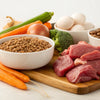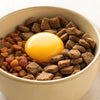Is Raw Dog Food Best? Exploring the Pros and Cons of a Raw Diet for Your Pet
- Houndsy
Table of Contents
- Introduction
- Understanding Raw Dog Food
- Nutritional Benefits of Raw Dog Food
- Risks and Concerns With Raw Dog Food
- Insights for Choosing a Feeding Style
- Balancing Convenience and Nutrition
- Conclusion
Introduction
Did you know that growing numbers of pet owners are opting to feed their furry companions a raw food diet? Recent statistics suggest that the sales of raw pet food have been surging by at least 15% each year. With around 15-25% of dogs now being fed some form of raw meat-based diet, it’s clear that this trend is not just a passing fad.
As devoted pet owners, we strive to make the best decisions for our four-legged friends. The question we often grapple with is: is raw dog food best for our pets? In this blog post, we will delve into the controversial topic of raw dog diets, examining their advantages and disadvantages, as well as offering insights into the proper way to approach feeding raw.
By the end of this article, we will equip you with a thorough understanding of raw dog food. We’ll discuss the nutritional aspects, potential health benefits, and inherent risks associated with this feeding style. Plus, we’ll explore how we can seamlessly integrate convenient feeding solutions into our daily routines to foster a healthier lifestyle for our beloved dogs. So, let’s take a closer look and determine whether we should make the leap to a raw dog's diet.
Understanding Raw Dog Food
What is Raw Dog Food?
Raw dog food typically consists of uncooked ingredients that might include muscle meat, organ meats, bones, fresh fruits, vegetables, eggs, and dairy products like yogurt. Known by monikers such as BARF (Biologically Appropriate Raw Foods) and RMBDs (Raw Meat-Based Diets), raw diets seek to replicate what our dogs' ancestors would have consumed in the wild.
Types of Raw Diets
Raw food diets can be broadly classified into two categories: commercial and homemade.
-
Commercial Raw Dog Food: These are ready-made options available in pet stores and online. They can come in various forms including frozen, freeze-dried, or dehydrated. High-quality commercial raw diets may include a variety of proteins and are designed to meet AAFCO (Association of American Feed Control Officials) standards.
-
Homemade Raw Dog Food: Many pet owners explore making their own raw diets. While this allows for greater control over ingredients, it also necessitates careful planning to ensure the diet is nutritionally complete and balanced. This typically requires guidance from a veterinary nutritionist.
Nutritional Benefits of Raw Dog Food
Improved Energy Levels and Coat Health
One of the primary benefits proponents cite for raw diets is the improved energy levels in dogs. Many owners report that after switching to a raw diet, their dogs exhibit increased vitality, demonstrate better focus during training sessions, and enjoy enhanced playtime experiences.
Additionally, the high fat content found in many raw foods can lead to shinier, healthier coats. Essential fatty acids from animal sources contribute to skin health, making it less prone to issues like dryness and irritation.
Dental Health Benefits
Raw diets can also enhance dental hygiene due to the natural chewing action that occurs when dogs gnaw on raw bones and meat. This chewing action can help reduce plaque and tartar buildup, leading to fresher breath and cleaner teeth.
Better Digestion
Some pet owners have noticed improvements in their dog's digestion when switching to raw. They often report firmer stools and decreased instances of gastrointestinal upset compared to kibble diets. The absence of fillers and high carbohydrate levels may be beneficial for dogs with specific food sensitivities or allergies.
Weight Management
Because raw dog food is typically higher in protein and lower in fiber than traditional kibble, it may help maintain a dog's body weight. By providing minimal carbohydrates, raw diets can deter weight gain, leading to healthier body conditions.
Risks and Concerns With Raw Dog Food
While there are potential benefits to a raw dog food diet, there are also significant risks pet owners must consider.
Bacterial Contamination
One of the largest concerns surrounding raw diets is the risk of bacterial contamination. Raw meat can harbor harmful pathogens like Salmonella, E. coli, and Listeria, which can pose serious health threats not only to pets but also to humans involved in handling the raw food. The Centers for Disease Control and Prevention (CDC) has issued warnings about these risks, particularly noting that dogs can be carriers of these bacteria without showing symptoms.
Nutritional Imbalance
Creating a balanced raw diet at home can be challenging. Nutritional imbalances are common, as many pet owners may not know how to provide all essential nutrients, leading to deficiencies or excesses that could cause long-term health issues for dogs. Without careful planning, we might be unintentionally depriving our dogs of critical vitamins and minerals.
Bone Hazards
Feeding whole bones presents risks around choking and tooth fractures. Bound to splinter, cooked bones can cause serious internal injuries, whereas not all raw bones are safe either; improper handling or preparation increases the danger of exposing our pets to these risks.
Insights for Choosing a Feeding Style
Consult Your Veterinarian
Before making any decisions regarding diet changes, we advise speaking with a veterinarian familiar with your dog's health history. This guidance is essential, especially if your pet has existing health issues, such as kidney problems or digestive disorders, that may be exacerbated by a raw diet.
Consider Your Lifestyle
How much time can you dedicate to meal prep? Are you prepared to handle raw food safely, ensuring proper sanitation to prevent cross-contamination? These are important considerations that can influence whether transitioning to raw is the right choice for you.
Balancing Convenience and Nutrition
As dog owners committed to their pets’ health, finding ways to enhance our dogs' feeding experiences matters, especially in overcoming the potential challenges of raw diets. Here at Houndsy, we've been dedicated to creating practical solutions to ease the feeding rituals for pet owners.
Our flagship product, the Houndsy Kibble Dispenser, exemplifies our commitment to convenience and design excellence. It allows for hassle-free dispensing of pre-measured kibble portions. By having a reliable mechanism for feeding dogs at standing height, we promote proper ergonomics while ensuring that every meal is a perfect portion without the mess.
The dispenser holds a considerable amount of kibble—between 25 to 30 pounds—making it a practical option for pet owners looking to reduce the frequency of grocery runs. We invite you to explore our Houndsy Kibble Dispenser here as a way to simplify your dog-feeding routine, while preserving the health of your beloved canine companion.
Conclusion
In summary, raw dog food diets present both intriguing possibilities and notable risks. As conscientious pet parents, understanding the complexities surrounding raw diets allows us to make informed feeding choices. While many report improved health and vitality in their dogs through raw diets, it’s essential to recognize the potential hazards that could affect our furry family members.
Our commitment at Houndsy is to elevate the dog-feeding experience, whether that involves raw diets or traditional kibble. By aligning with quality, convenience, and style, we can enhance not only our pets' nutrition but also our own daily lives.
FAQ Section
1. Is raw dog food safe for all dogs? No, raw diets may not be suitable for puppies, elderly dogs, or those with underlying health issues. Always consult a veterinarian.
2. What are the signs my dog may be allergic to their food? Symptoms can include gastrointestinal upset, skin irritations, and persistent itching. If you suspect allergies, speak with your vet about testing and dietary management.
3. How can I ensure a homemade raw diet is balanced? Consider consulting a veterinary nutritionist to create a tailored plan that ensures your dog receives all necessary nutrients.
4. Does raw dog food lead to cleaner teeth? Yes, the chewing action involved with raw bones can promote better dental hygiene compared to some kibble diets.
5. What are the signs of bacterial infection in dogs? Symptoms can include vomiting, diarrhea, fever, and decreased appetite. If you notice these signs, consult your vet immediately.
By embracing a deeper understanding of our dogs’ diets and choosing ideal feeding solutions, we can improve their lives while enjoying a fulfilling connection with our pets. Let's continue loving and caring for our furry friends while making responsible, well-informed choices.
Explore more ways to enhance your dog's feeding experience with the Houndsy Kibble Dispenser here.












